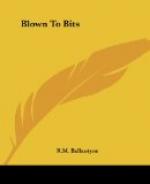The orang moved uneasily, but still declined to go.
Turning sharply on it, the professor bent down, placed a hand on each of his knees and stared through the blue goggles into the animal’s face.
This was more than it could stand. With a very bad grace it hobbled off to the Durian tree, ascended it with a sort of lazy, lumbering facility, and hurled down some of the fruit without warning those below to look out.
“My little frond is obstinate sometimes,” remarked the naturalist, picking up the fruit, “but ven I bring my glasses to bear on him he alvays gives in. I never found zem fail. Come now; eat, an’ ve vill go to vork again. Ve must certainly find zee booterflies somevere before night.”
[Illustration: “DO YOU HEAR?” SAID VERKIMIER, STERNLY.—PAGE 187.]
But Verkimier was wrong. It was his destiny not to find the butterflies that night, or in that region at all, for he and his companion had not quite finished their meal when a Dyak youth came running up to them saying that he had been sent by the Rajah to order their immediate return to the village.
“Alas! ve most go. It is dancherous to disobey zee Rajah—ant I am sorry—very sorry—zat I cannot show you zee booterflies to-day. No matter.—Go” (to the Dyak youth), “tell your chief ve vill come. Better lock zee next time!”
CHAPTER XV.
HUNTING THE GREAT MAN-MONKEY.
Although Professor Verkimier had promised to return at once, he was compelled to encamp in the forest, being overtaken by night before he could reach the river and procure a boat.
Next morning they started at daybreak. The country over which they passed had again changed its character and become more hilly. On the summits of many of the hills Dyak villages could be seen, and rice fields were met with as they went along. Several gullies and rivulets were crossed by means of native bamboo bridges, and the professor explained as he went along the immense value of the bamboo to the natives. With it they make their suspension bridges, build their houses, and procure narrow planking for their floors. If they want broader planks they split a large bamboo on one side and flatten it out to a plank of about eighteen inches wide. Portions of hollow bamboo serve as receptacles for milk or water. If a precipice stops a path, the Dyaks will not hesitate to construct a bamboo path along the face of it, using branches of trees wherever convenient from which to hang the path, and every crevice or notch in the rocks to receive the ends of the bamboos by which it is supported.




